Catholic Customs
 |
 |
 |
 |
 |
 |
 |
Catholic Charity & St. Joseph’s Tables
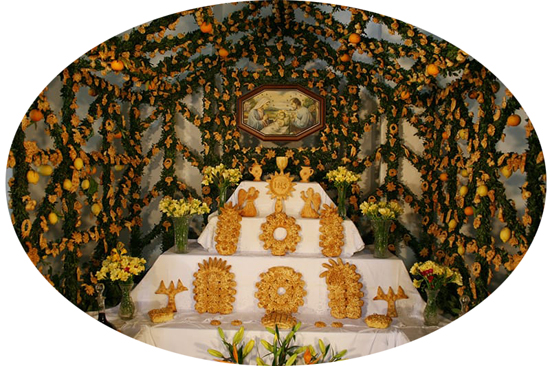
“O blessed Saint Joseph, how great was thy worth,
The one chosen shadow of God upon earth…
For thou to the pilgrim art father and guide,
And Jesus and Mary felt safe by thy side…”
- Fr. Frederick Faber
St. Joseph’s illustrious example of fulfilling the duties of domestic life has always raised the admiration of Catholic families who strive to imitate his virtues. This desire manifested itself in Catholic society through special customs. By the 17th century, many families had adopted the custom of setting a statue of St. Joseph in a place of honor at the dinner table with a full plate of food before him. This food was distributed to the poor after the meal. (1)
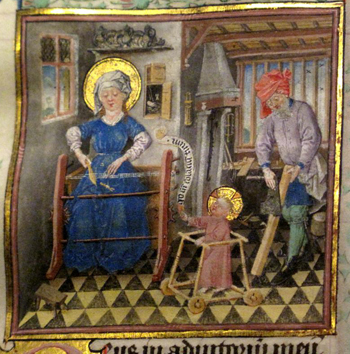
St. Joseph working on carpentry with the Holy Family
To honor St. Joseph’s role as the provider of bread for the Holy Family, many European housewives would bake small round loaves called St. Joseph’s Loaves for his feast. In some areas, dispensations were even granted to the men and women named after St. Joseph to mitigate the rigors of Lent by enjoying festive meatless dishes on their name day. (3)
Carpenters from the Austrian district of Berchtesgardener Land brought Baumwollbrot (Sweet Cotton Bread) to Mass on St. Joseph’s day to have the loaves blessed. (4) Throughout Southern Germany, Austria and Poland, the people enjoyed pretzels and Josephi beer (a dark malt beer) on this feast, which was often the day chosen for tapping the beer. (5)
St. Joseph’s Tables
Foods made in honor of so generous a Saint could not but inspire the people to share with the poor. This generosity towards the poor is found even to this day, most prominently in Italy, where devotees of St. Joseph abound.
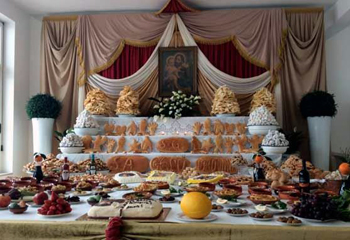
A table generously laden with many dishes; below, an altar in Sicily adorned with garlands of orange, bread & greenery
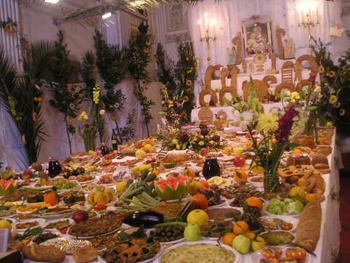
Every member of the village contributes a dish of food, candles, flowers or money to make their St. Joseph’s Table as beautiful as possible. Many of these generous gifts are given in fulfillment of vows as offerings of gratitude for favors the families have received from St. Joseph. Often new favors have been granted to families who make altars. (6)
These private altars require a sacrifice from the families that make them, for the tables must be overflowing with abundant food (some families make the goal of 100 dishes) and the altars must be intricately constructed with greenery, flowers, fruits and candles. In the old days, when women baked everything from scratch, housewives invited friends and neighbors to assist them in the tremendous task of baking the numerous breads for the table, a task that often took 10 full days to complete. (7)
This tradition originated in the Middle Ages when Sicily was struck by a terrible drought and famine. The stricken people implored St. Joseph for relief. Abundant rain soon fell and the people had a fruitful harvest.
In thanksgiving for this favor, the people offered their best crops to the Saint, distributing the abundance from the harvest to the poor. So grateful were they to their dear St. Joseph that they resolved to do so ever afterward on his Feast Day.
The Sicilians were faithful to their vow, and their example inspired Italians in other regions to adopt the custom. As Italians immigrated to other countries, they shared this charming custom so that today in Poland, the Czech Republic and the United States (especially in New Orleans, New York and New Jersey) St. Joseph’s altars can also be found even to this day.
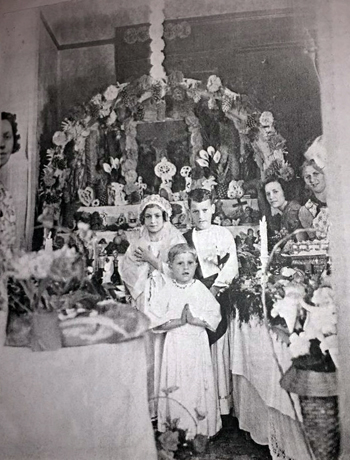
Three children represent the Holy Family,
New Orleans, 1939
Before the feast, the village priest said a solemn Mass in honor of St. Joseph at which all were present. Following the Mass, the priest and villagers led the Holy Family in procession to the St. Joseph’s Table where the priest blessed the table and all its contents.
The Holy Family, seated at a high table near St. Joseph’s Table, were served their courses first, afterwards the other guests could eat. In many areas, 12 or 13 courses had to be served in honor of the Twelve Apostles and Our Lord and three portions of each course were set on each plate in honor of the Holy Trinity.
These ceremonies continue today, but in most places the Holy Family is no longer portrayed by poor villagers.
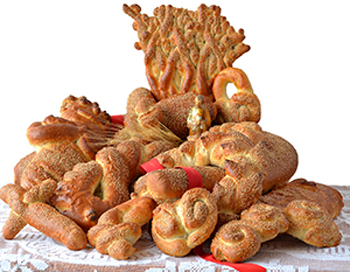
The symbolic loaves of St. Joseph’s table
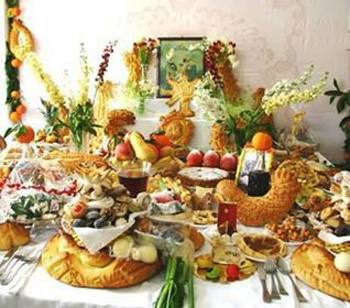
Crops from the harvest such as fava beans, olives, figs, sheaves of wheat, oranges, lemons and grapes also grace the altar in accordance with the old tradition. Devout people often save one blessed fava bean (the one crop that still grew during the drought of the Middle Ages) and carry it in their pockets in order to obtain from St. Joseph the favor to never be without coins. (9) Wine is also an important part of the meal, symbolic of the Wedding of Cana.
Little cream puffs (Sfinge di San Guiseppe) are a favorite sweet to serve on this day in many villages, because of a legend that St. Joseph sold pastries to help provide for the Holy Family during their exile in Egypt. (10) Another legend is that the Christ Child played with pine cones in his childhood, so some villages serve pine cone shaped pastries (Pignolatti) to honor Him.
The most important foods on the St. Joseph’s Table are the symbolically shaped loaves of bread. The largest loaf (pane grosso) is braided and shaped in the form of St. Joseph’s flowering staff. Two more large loaves are made, one shaped in a symbol of Our Lady and the other for Our Lord. These three breads are placed on the top tier of the altar with the bread for Our Lord in the center, Our Lady’s bread on the right and St. Joseph’s on the left. (11)
Numerous smaller loaves are formed in nearly every shape imaginable: There are fruits, flowers, birds, lambs, suns, moons and symbolic items related to the life of the Holy Family. Our Lord is represented by monstrances, chalices, crosses, nails, the crown of thorns and other such symbols. Carpenter’s tools, staffs and breads shaped like beards give honor to St. Joseph, while breads marked with an “M” signify Our Lady.
These loaves are blessed by a priest and distributed to all the guests, who preserve pieces of the bread in their homes for protection and preservation from a violent death.
In the past, after all of the poor had taken their fill of the many delicacies and were given extra food to take home, the Holy Family mounted mules and once again processed through the streets. As they passed through the streets, the villagers hailed them with exclamations of joy and offered them gifts and food as they passed by, for they believed that the Holy Family in Heaven would accept their offerings to these poor people as though it had been given to them. (12)
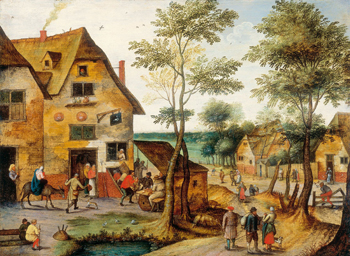
The Holy Family searching for an inn in a small medieval village
How inspiring are these customs that provided alms for the poor in so charming a manner! In the midst of Lent when all were fasting, the Catholics of Sicily found a way to give an abundance of food to the poor who suffered from hunger the whole year. If St. Joseph inspired such charity in the past, may he continue to do so and may many more St Joseph’s Tables fill the streets and homes of pious Catholics in these times.
Such small gestures made in the name of St. Joseph cannot but bring Our Lady’s Reign closer.
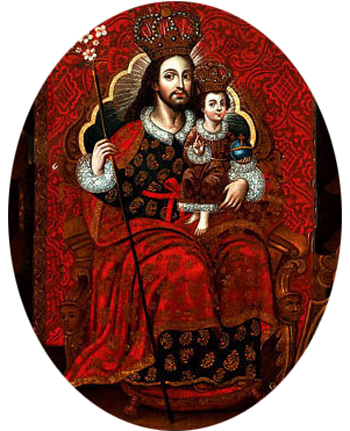
The grandeur of St. Joseph
- Francis X Weiser, The Holyday Book (London: Staples Press Limited), p. 158.
- https://littlevillagemag.com/st-patricks-and-st-josephs-day-parades-fill-the-streets-of-cedar-rapids-this-weekend/
- http://annhetzelgunkel.com/easter/swjozef.html
- http://kitchenlioness.blogspot.com/2020/03/sweet-cotton-bread-for-saint-josephs.html
- http://www.brauchtumskalender.at/brauch-162-josefitag
- Katherine Burton and Helmut Ripperger, Feast Day Cookbook (Catholic Authors Press, 2005), p. 41 .
- Carol Field, Celebrating Italy (New York: William Morrow and Company, 1990), p. 393.
- https://yearofstjoseph.org/devotions/st-joseph-table/
- Ann Ball, Catholic Traditions in Cooking (Huntington, Indiana: Our Sunday Visitor, 1993), p. 96-97.
- http://polishatheart.com/polish-st-josephs-day-and-breaking-of-lent
- Carol Field, Celebrating Italy (New York: William Morrow and Company, 1990), p. 394-396.
- Dorothy Gladys Spicer, Festivals of Western Europe (New York: The H. W. Wilson Company, 1958), p. 100-101.
- https://www.catholicculture.org/culture/liturgicalyear/activities/view.cfm?id=1031 and https://www.saintsfeastfamily.com/copy-of-st-joseph-march-19-2

Posted March 17, 2023
______________________
______________________
 |
 |
 |
 |
 |
 |


